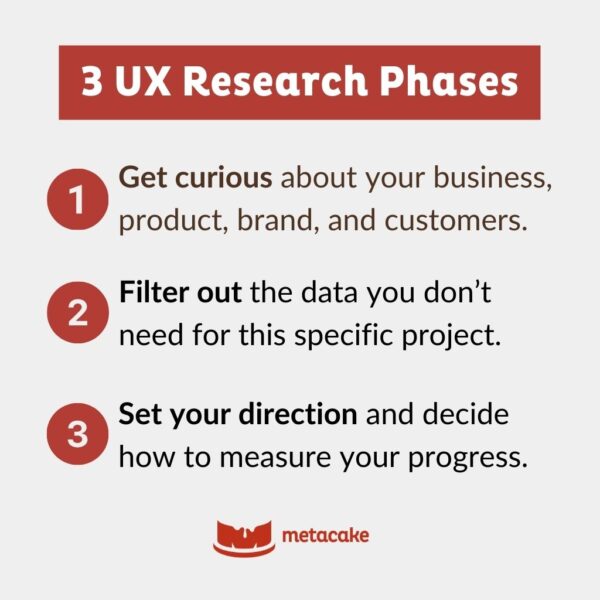
THE 3 PHASES OF UX RESEARCH: YOUR KEY TO EFFECTIVE UX DESIGN
In the world of ecommerce, customer experience is king. Whether you call it UX, user experience, or customer experience, it all boils down to how customers interact with your brand, products, and company.
Since UX is so important, you should get designing immediately, right? Not so fast.
Effective UX design requires laying some significant groundwork through thorough research. Many companies make the mistake of skipping UX research and jumping straight into design, blindly following the latest trends or best practices without considering their unique context. Don’t fall into this trap.
Investing adequate time and resources into UX research ensures you have a deep understanding of your brand, products, industry, and target audience. You can then make informed, strategic design decisions tailored to your ecommerce business.
To get the data you need, make sure you spend time in each of the three major UX research phases, which we walk through below.

3 UX Research Phases to Build Your Roadmap
Trying to navigate UX design without UX research is like taking a road trip without a map (or GPS). You might think you’re heading in the right direction, but you can quickly find yourself lost, facing unexpected obstacles, and ultimately failing to reach your goal.
UX research is your roadmap to effective UX design. And each of the UX research phases ensures you have an accurate, helpful map to work from.
Phase 1: Get Curious
Every good cartographer needs a healthy dose of curiosity. Assumptions about the terrain — even apparently reasonable ones — can introduce errors that lead travelers in circles.
Similarly, the first phase of your UX research involves asking questions (LOTS of questions). You need to get curious about your business, your brand, and your customers — even, and perhaps especially, when you think you already know the answers.
Start with questions like:
- What are your core values?
- What does your brand offer?
- Who are your customers?
- What do they need?
- How do you differ from your competition?
Since mapping a business is significantly less tangible than mapping, say, a forest or city, you’ll likely make some assumptions along the way. The important thing here is to recognize when you’re making an assumption — and attempt to test it.
You might conduct formal user testing with focus groups or surveys, or you might go the informal route and ask colleagues, friends, or family for input. The latter obviously leaves room for bias, but the point is to check your assumptions quickly so you know whether you’re accurately assessing all the components for your map.
Developing a deep, objective understanding of the elements of your brand, business model, product(s), and customers allows you to sketch an accurate lay of the land. Then, the possible pathways (and potential roadblocks) toward your goal start to take shape.
Phase 2: Filter the Noise
Imagine if your GPS included every tree, bush, and 7-Eleven on its screen (or worse, in its audio). You’d be overwhelmed in minutes, all that data proving more hindrance than help.
Once you ask the important questions and get a lay of the land, you need to determine what information is relevant and what’s just noise. The filter: Which elements should remain as part of your map for this specific journey?
To remove unnecessary elements, you’ll need to:
- Define what you’re building — a new mobile app, an email marketing campaign, a redesigned website, etc.
- Know your goal — increased conversions, better customer retention, a smoother checkout process, etc.
When you’re clear on the project and your UX design goal, you’ll have the parameters you need to filter out clutter and retain key components.
Phase 3: Set Your Direction
The last of the three UX research phases is to clearly define a specific goal and how you’ll measure success.
If you were preparing to drive from San Francisco to New York, you wouldn’t type “East Coast” into your GPS. You’d narrow in on the city and probably the name of your hotel.
What’s the specific destination of your UX design? Are you looking for increased site visits, new leads, ecommerce conversions, or simply more brand engagement? Great. Put that in the GPS; it’s even better if you aim for some specific metrics.
Now, how will you know you’re on the right path? Define how you’ll measure progress and define success. What data will you track? How do you know when you reach your destination?

UX Research Phases: Make Your Map
Only after passing through all three UX research phases can you begin the actual process of good UX design. They’re the safeguards that keep you from chasing mirages and wasting resources on roads that lead to nowhere.
To get where you want to go, you first have to know where you are. UX research is the starting point that gets you to an end product that works.



